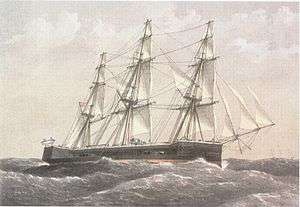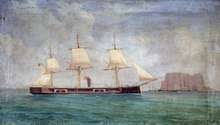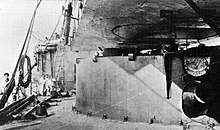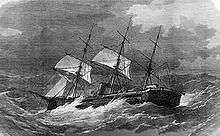HMS Captain (1869)
HMS Captain was an unsuccessful warship built for the Royal Navy due to public pressure. She was a masted turret ship, designed and built by a private contractor against the wishes of the Controller's department. The Captain was completed in April 1870 and capsized on 07 September 1870 with the loss of nearly 500 lives because of design and construction errors that led to inadequate stability.[2]
 HMS Captain | |
| History | |
|---|---|
| Ordered: | November 1866 |
| Builder: | Laird Brothers, Birkenhead |
| Laid down: | 30 January 1867 |
| Launched: | 27 March 1869 |
| Commissioned: | April 1870 |
| Fate: | Sunk; 7 September 1870 |
| General characteristics [1] | |
| Displacement: |
|
| Length: | 320 ft (97.54 m) pp |
| Beam: | 53 ft 3 in (16.23 m) |
| Draught: | 24 ft 10 in (7.57 m) |
| Propulsion: |
|
| Sail plan: | Ship rig: 37,990 sq ft (3,529 m2) of sail (max) |
| Speed: | 15.25 kn (28.24 km/h; 17.55 mph) (steam power) |
| Complement: | 500 crewmen and officers |
| Armament: |
|
| Armour: |
|
Background
The history of the Captain can be traced back to the Crimean War and the experiences of British captain Cowper Phipps Coles in 1855. Coles and a group of British sailors constructed a raft with guns protected by a "cupola" and used the raft, named the Lady Nancy, to shell the Russian town of Taganrog on the Black Sea. The Lady Nancy "proved a great success",[3] and Coles patented his rotating turret after the war. Following Coles' patenting, the British Admiralty ordered a prototype of Coles' design in 1859, which was installed in the floating battery vessel, HMS Trusty, for trials in 1861.
The trials with the Trusty impressed the Admiralty, and it ordered a coastal defence vessel, HMS Prince Albert, to be built with four of Coles' turrets and a wooden 121-gun first rate ship-of-the-line under construction, HMS Royal Sovereign, to be converted to a turret ship. The Prince Albert was completed with four turrets mounting single 12-ton 9-inch guns and 4.5-inch-thick (110 mm) armour plate on the hull. The Royal Sovereign had five 10.5-inch, 12.5-ton guns in one twin and three single turrets.[4]
Both ships were flush deck with only a jury rig, and could only operate as coastal service vessels.[5] The Admiralty, although impressed with Coles' rotating turret, required oceangoing vessels to protect its worldwide empire. Unfortunately for Coles, engine technology had not yet caught up with his designs and consequently oceangoing ships required sails. Combining rigging, masts, and turrets proved complicated if rigging was not to impede the turrets' arcs of fire.
In early 1863 the Admiralty gave Coles permission to work with Nathaniel Barnaby, head of staff of the Department of Naval Construction, on the design of a rigged vessel with two turrets and three tripod masts. In June 1863 the Admiralty suspended progress on the vessel until the Royal Sovereign finished her trials.
In 1864, Coles was allowed to start a second project: a rigged vessel with only one turret and based on the design of HMS Pallas. He was lent the services of Joseph Scullard, Chief Draughtsman of Portsmouth Dockyard.[6]
The next year, 1865, a committee established by the Admiralty to study the new design concluded that while the turret should be adopted, Coles' one-turret warship design had inadequate fire arcs.[7] The committee proposed a two-turret fully rigged vessel with either two 9-inch (12 ton) guns per turret, or one 12-inch (22 ton) gun per turret. The committee's proposal was accepted by the Admiralty, and construction was started on Monarch. Monarch's two turrets were each equipped with two 12-inch (25-ton) guns.
Stunned by the committee's decision to cancel his single-turret ship and his proposal for a two-turret vessel, and objecting to the Monarch's design, Coles launched a strong campaign against the project, attacking Robert Spencer Robinson, Controller of the Navy, and various other members of the committee and the Admiralty. So vociferously did Coles complain that in January 1866 his contract as a consultant to the Admiralty was terminated. At the end of January, his protestations that he had been misunderstood led to his being re-employed from 1 March 1866.[8] Further, Coles lobbied the press and Parliament and was eventually able to force the Admiralty to allow him to build his own two-turret design.
Design and construction

On 8 May 1866, Coles informed the Admiralty of his selection of Laird Brothers' Cheshire yard, for the builder of the warship. The Cheshire yard had already built several successful iron warships. In mid-July, Lairds submitted two possible designs for Coles' proposed turret-ship.[9] To prevent the rigging from being damaged when the guns fired through it, it was attached to a platform mounted above the gun turrets known as the hurricane deck instead of brought down to the main deck. Tripod masts were also used to minimise standing rigging.[1]

The design called for the ship to have a low freeboard, and Coles' figures estimated it at 8 feet (2.4 m). Both the Controller Vice-Admiral Sir Robert Spencer Robinson and the Chief Constructor Edward James Reed raised serious concerns. Robinson noted that the low freeboard could cause flooding issues on the gun deck, and Reed criticised the design in 1866 both for being too heavy and for having too high a centre of gravity. On the latter, Reed noted that it would cause issues "especially as it is proposed to spread a large surface of canvas upon the Captain".[10] As the design neared completion, the First Lord of the Admiralty, Sir John Pakington, wrote on 23 July 1866 to Coles approving the building of the ship, but noting that responsibility for failure would lie on Coles' and the builders' lap.[11]
In November 1866, the contract for HMS Captain was approved,[9] and the design was finished. She was laid down 30 January 1867 at Laird's yard at Birkenhead, England, launched 27 March 1869[1] and completed in March 1870.[12]
Insufficient supervision during the building, owing partly to Coles' protracted illness,[13] meant that she was 735 long tons (747 t) heavier than planned.[14] The designed freeboard was just 8 feet (2.4 m), and the additional weight forced her to float 22 inches (0.56 m) deeper than expected, bring the freeboard down to just 6 feet 6 inches (1.98 m).[15] This compares with 14 feet (4.3 m) for the two-turret Monarch.[16] The centre of gravity of the vessel also rose by about ten inches during construction. Reed raised havoc over the problems with the freeboard and the centre of gravity, but his objections were over-ruled during the Captain's trials.[14]
She was commissioned on 30 April 1870 under Captain Hugh Talbot Burgoyne, VC. During trials in the following months, the Captain seemed to be everything that Coles promised and won over many followers. In trials versus the Monarch, she performed well and returned to sea in July and August, travelling to Vigo, Spain, and Gibraltar in separate runs.
Gunnery trials

A trial was undertaken in 1870 to compare the accuracy and rate of fire of turret-mounted heavy guns with those in a centre-battery ship. The target was a 600 feet (180 m) long, 60 feet (18 m) high rock off Vigo. The speed of the ships was 4–5 knots (4.6–5.8 mph; 7.4–9.3 km/h) ("some accounts say stationary").[17] Each ship fired for five minutes, with the guns starting "loaded and very carefully trained".[17] The guns fired Palliser shells with battering charges at a range of about 1,000 yards (0.91 km).[17] Three out of the Captain's four hits were achieved with the first salvo; firing this salvo caused the ship to roll heavily (±20°); smoke from firing made aiming difficult.[17] Note that the Captain could be expected to capsize if inclined 21°.[18] The Monarch and the Hercules also did better with their first salvo, were inconvenienced by the smoke of firing, and to a lesser extent were caused to roll by firing.[17] On the Hercules the gunsights were on the guns, and this worked better than the turret roof gunsights used by the other ships.[17]
| Ship | Weapons firing | Rounds fired | Hits | Rate of fire (rounds per minute) |
|---|---|---|---|---|
| Hercules | 4 x 10 inch MLR | 17 | 10 | 0.65 |
| Monarch | 4 x 12 inch MLR | 12 | 5 | 0.40 |
| Captain | 4 x 12 inch MLR | 11 | 4 | 0.35 |
| Source:[17] | ||||
Sinking

On the afternoon of 6 September 1870 Captain was cruising with the combined Mediterranean and Channel Squadrons comprising 11 ships off Cape Finisterre. The ship made 9.5 knots under sail in a force six wind, which was increasing through the day. The commander in chief, Admiral Sir Alexander Milne,[19] was on board to see her performance, and speed had risen to 11–13 knots before he departed. Not being accustomed to ships with such low freeboard, he was disturbed to note that at this speed with the strengthening sea, waves washed over the weather deck. The weather worsened with rain as the night progressed, and the number of sails was reduced. The wind was blowing from the port bow so that sails had to be angled to the wind, speed was much reduced, and there was considerable force pushing the ship sideways. As the wind rose to a gale, sail was reduced to only the fore staysail and fore and main topsails.[20]

Shortly after midnight when a new watch came on duty, the ship was heeling over eighteen degrees and was felt to lurch to starboard twice. Orders were given to drop the fore topsail and release sheets (ropes) holding both topsails angled into the wind.[21] Before the captain's order could be carried out, the roll increased, and she capsized and sank with the loss of around 480 lives, including Coles. The First Lord of the Admiralty, Hugh Childers, and Under-Secretary of State for War, Thomas Baring, both lost sons in the disaster. Only 27 of the crew survived, many by making it to a boat which had broken free.[22]
Court-martial
The subsequent investigation on the loss of Captain, in the form of a court-martial,[23] under Sir James Hope, took place on board HMS Duke of Wellington, in Portsmouth Harbour. It was somewhat of a departure for the Admiralty to seek scientific advice, but eminent engineers William Thomson (later Lord Kelvin) and William John Macquorn Rankine were appointed to the enquiry. It concluded that the ship was insufficiently stable: at 14 degrees heel (when the edge of the deck touched the sea) the righting moment due to the buoyancy pushing the ship upright again was just 410-foot-tons (1.2 MN·m). HMS Monarch, the masted turret ship proposed by the 1865 committee and designed by Reed, and which was in the area at the time of the sinking, had a righting moment of 6,500-foot-tons (20 MN·m) at the same angle.[24] Maximum righting moment occurred at a heel of 21 degrees, and thereafter declined to zero at 54.5 degrees. Monarch's righting moment increased to a maximum at 40 degrees.[25] Survivors testified that the Captain floated upside down for between three and ten minutes, which proved that the ship had capsized.[16] An inclining test had been carried out at Portsmouth on 29 July 1870 to allow the ship's stability characteristics to be calculated. Captain set sail on the ship's final voyage before the results of the trial were published.[26]
The inquiry concluded that "the Captain was built in deference to public opinion expressed in Parliament and through other channels, and in opposition to views and opinions of the Controller and his Department".[27]
Memorials
There are memorials to the crew in St Paul's Cathedral, Westminster Abbey, London, and St. Anne's church in Portsmouth.
The conclusion of the 1870 Court Martial is engraved upon the Memorial to the loss of H.M.S. Captain, in the north aisle of St. Paul’s Cathedral. One doubts that Captain Coles or any of those involved, from the First Lord of the Admiralty and First Sea Lord down, could have taken exception to the Inquiry’s conclusion, apportioning the blame all round as it does:
- Before the Captain was received from her contractors a grave departure from her original design had been committed whereby her draught of water was increased about two feet and her freeboard was diminished to a corresponding extent, and that her stability proved to be dangerously small, combined with an area of sail, under those circumstances, excessive. The Court deeply regret that if these facts were duly known and appreciated, they were not communicated to the officer in command of the ship, or that, if otherwise, the ship was allowed to be employed in the ordinary service of the Fleet before they had been ascertained by calculation and experience.
Notes
- Chesneau and Kolesnik 1979, p. 21.
- Macintyre, Donald; Bathe, Basil W (1974). Man of War a History of the Combat Vessel. Reference to the capsize and sinking. Mcgraw-hill Inc. p. 103. ISBN 9780070445857.
- Preston 2002, p. 21.
- Brown 2003, pp. 42–44.
- This kind of vessel is often referred to as a coast defence ship, some argue there was nothing defensive about the role intended for Royal Sovereign – she was intended for attack for enemy ports such as Cherbourg But there is little evidence to support this claim. Coles himself envisaged a fleet of such vessels replacing three-decker ships-of-the-line (of which Royal Sovereign was the prototype) and 'blockships' for coast defence first and possibly as alternatives to sea-going ironclads like HMS Warrior second. Few at the Admiralty seriously considered the idea of trusting turret-ships against the multi-layered, modern coastal defences networks of 1st-class naval arsenals such as Cherbourg or Cronstadt or even New York Harbor. Royal Sovereign drew too much water, had a slow rate of fire and relatively high-profile compared with American turret varieties (the monitors) which themselves failed to blast their way into Charleston harbor in 1863.
- Brown 2003, p. 44.
- Preston 2002, p. 22.
- Brown 2003, p. 47.
- Preston 2002, p. 23.
- Hawkey, Arthur: HMS Captain. G. Bell, 1963, page 52
- Brown 2003, pp. 47–48.
- Preston 2002, p. 24.
- Dalrymple Hay, Sir John Charles: Remarks on the loss of H.M.S. "Captain". E. Stanford, 1871, page 33
- HMS Captain
- Paine, Lincoln P.: Warships of the World to 1900. Volume 799. Houghton Mifflin Harcourt, 2000, page 31. ISBN 0-395-98414-9
- Scott Russell, John (1870). "The Loss of the Captain". Macmillan's Magazine. p. 477.CS1 maint: ref=harv (link)
- Brown, David K (1997), Warrior to Dreadnought, Chatham Publishing, p. 50, ISBN 1861760221
- An inclining test at Portsmouth conducted on 29 July 1870 suggested that the Captain's extreme heel with safety in smooth water was 15°-16°; calculations completed by 23 August 1870 showed that her danger angle was 21°, as had been predicted by Lairds in January or February 1870.
Parkes, Oscar (1966), British Battleships (2 ed.), pp. 141–2
Brown, David K (1997), Warrior to Dreadnought, Chatham Publishing, pp. 48, 50–51, ISBN 1861760221 -
Ballard, George Alexander (1980), The black battlefleet, Nautical Publishing Company Ltd, pp. 110-1, ISBN 0245530304
Fitzgerald, Penrose (1913), Memories of the sea, Edward Arnold, pp. 278–9 - Padfield p.50
- Padfield p.51
- Stanley Sandler (2004). Battleships: An Illustrated History of Their Impact. ABC-CLIO. p. 32. ISBN 978-1-85109-410-3.
- Brown 2003, p. 51.
- Reed, Edward James: A treatise on the stability of ships. C. Griffin and company, 1885, page 346
- Padfield p. 50
- Brown 2003, p. 50.
- Beeler, John Francis: British naval policy in the Gladstone-Disraeli era, 1866–1880. Stanford University Press, 1997, page 114. ISBN 0-8047-2981-6
References
| Wikimedia Commons has media related to HMS Captain (1869). |
- Archibald, E.H.H.; Ray Woodward (ill.) (1971). The Metal Fighting Ship in the Royal Navy 1860–1970. New York: Arco Publishing Co.. ISBN 0-668-02509-3.
- Ballard, Admiral G.A. The Black Battlefleet, published Nautical Publications Co. and Society for Nautical Research, 1980. ISBN 0-245-53030-4
- Brown, D.K. Warrior to Dreadnought: Warship Development 1860–1905. London: Caxton Editions, 2003. ISBN 1-84067-5292.
- Chesneau, Roger and Eugene M Kolesnik. Conway's All The World's Fighting Ships 1860–1905. London: Conway Maritime Press, 1979. ISBN 0-85177-133-5.
- Padfield, Peter, The Battleship Era. London: The military book society, 1972.
- Preston, Antony. The World's Worst Warships. London: Conway Maritime Press, 2002. ISBN 0-85177-754-6.
- Sandler, Stanley "The Emergence of the Modern Capital Ship" London, Newark, Del., 1979. ISBN 978-0874131192.